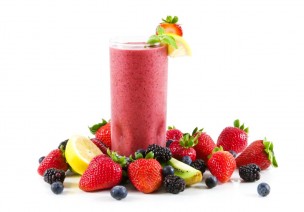Smoothies Equal Satisfaction
By Caitlin O’Keeffe
Contributing Writer
Let’s throw subtlety to the wind: I love smoothies.
They are smoother than Ryan Gosling saying, “Hey girl,” and they’re highly versatile—so much that if you don’t like smoothies, you either aren’t trying hard enough to accommodate your preferences, or you’re trying too hard to be above delicious, frothy fun. When made properly, smoothies add a touch of whimsy and an unquantifiable amount of yumminess to “healthy eating.”
That said, I hear a lot of misguided talk about smoothies. Some consider “smoothie” a nutritional buzzword, even if it refers to blended ice cream and Oreos (which I am not necessarily criticizing). Others pigeonhole them as snacks or sides and consume a meal-sized serving of smoothie on top of their main course. And then there are those who consume a snack-sized portion as a meal, or a so-called “meal replacement,” often as a part of a fad crash-diet.
A drink that supports a more positive representation of smoothies is the “Green Monster.” I am often asked, “What is a Green Monster smoothie?” Well, for starters, it’s my motivation to get to the gym in the morning. Though I fancy myself intrinsically motivated to be active, I know that many a morning workout has been inspired by the thought of a magically delicious smoothie awaiting my return at home.
But basically, a Green Monster is your average-Joe smoothie with a not-so-average power boost: spinach. Or kale. Or anything green and nutritious. Before you cringe, let me debunk the myth that the smoothie will taste like spinach. It doesn’t. The other ingredients make short work of the vegetable taste, and the flavor permutations are endless: fruit, yogurt, protein powder, chia seeds, flax seeds, peanut butter, almond butter, maple syrup, cocoa powder, almond milk, coconut milk, regular milk, juice, water, coffee, et cetera. You name it, you blend it.
When drinking a Green Monster, you are treating yourself kindly. You’re giving both your body and soul a complete serving of the carbohydrates, protein, and overall yumminess that it needs in order to thrive and feel satiated.
And if you want to super-size your smoothie without piling on the calories, just add five to seven ice cubes. Cha-ching!
Smoothies Equal Sugar
By Samantha Lau
Contributing Writer
Smoothies are the health craze of the moment. People have been using these drinks as a meal replacement in the hopes of losing weight or improving their overall well-being. However, when it comes down to it, smoothies aren’t as great as they may seem.
Basically, a smoothie is a drink packed with tons of calories and sugar, comparable to a soft drink. Yes, smoothies do contain natural sugars, but sugar is sugar nevertheless. Eating and chewing solid food tends to keep you more satiated than sipping away on a smoothie; without realizing it, you can take in anywhere from 300 to 500 calories and 60 grams of sugar in one drink alone.
For example, in Jamba Juice’s Banana Berry Smoothie, there are 300 calories and 59 grams of sugar packed into a 16 oz. drink. Because of the smoothie’s high sugar content, your insulin levels will spike dramatically upon consumption. Moreover, when fruits or vegetables are blended into a smoothie, the fiber is consequently stripped away. As a result, the drinker may experience premature hunger pangs, which could cause overeating and weight gain.
Also, the amount of fruits and vegetables many people put in their smoothies can be alarming. You wouldn’t usually consume the same amount of raw fruits and vegetables you would blend into a smoothie; instead, you would have one or two fruits at a time, or a serving of vegetables.
Let me be clear: I’m not saying you should remove smoothies from your life completely. However, if you are planning to drink a smoothie, it is certainly better to make it yourself, which allows you to have total control over the ingredients, rather than buying one from a supermarket or store. Personally, I recommend adding more vegetables than fruit. Vegetables are typically more nutritionally dense and have a lot less sugar and calories than fruits do.
The moral of the story is that smoothies should be treated as an occasional indulgence and not as a daily meal replacement. As my parents have always said, just eat your fruits and vegetables.

Comments are closed